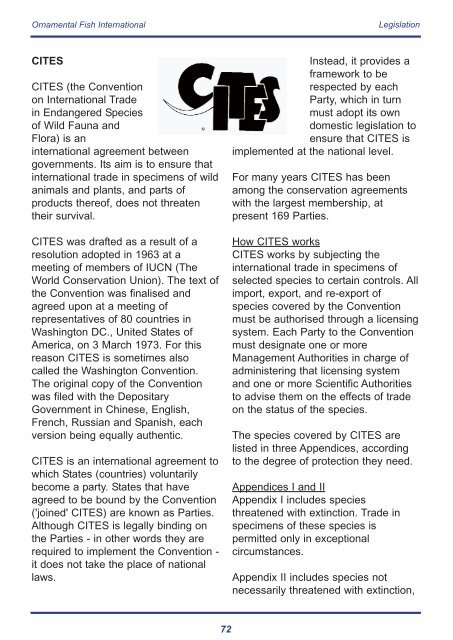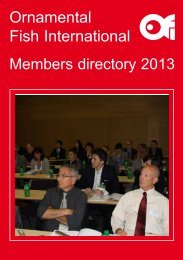Import and Export legislation - Ornamental Fish International
Import and Export legislation - Ornamental Fish International
Import and Export legislation - Ornamental Fish International
Create successful ePaper yourself
Turn your PDF publications into a flip-book with our unique Google optimized e-Paper software.
<strong>Ornamental</strong> <strong>Fish</strong> <strong>International</strong><br />
CITES<br />
CITES (the Convention<br />
on <strong>International</strong> Trade<br />
in Endangered Species<br />
of Wild Fauna <strong>and</strong><br />
Flora) is an<br />
international agreement between<br />
governments. Its aim is to ensure that<br />
international trade in specimens of wild<br />
animals <strong>and</strong> plants, <strong>and</strong> parts of<br />
products thereof, does not threaten<br />
their survival.<br />
CITES was drafted as a result of a<br />
resolution adopted in 1963 at a<br />
meeting of members of IUCN (The<br />
World Conservation Union). The text of<br />
the Convention was finalised <strong>and</strong><br />
agreed upon at a meeting of<br />
representatives of 80 countries in<br />
Washington DC., United States of<br />
America, on 3 March 1973. For this<br />
reason CITES is sometimes also<br />
called the Washington Convention.<br />
The original copy of the Convention<br />
was filed with the Depositary<br />
Government in Chinese, English,<br />
French, Russian <strong>and</strong> Spanish, each<br />
version being equally authentic.<br />
CITES is an international agreement to<br />
which States (countries) voluntarily<br />
become a party. States that have<br />
agreed to be bound by the Convention<br />
('joined' CITES) are known as Parties.<br />
Although CITES is legally binding on<br />
the Parties - in other words they are<br />
required to implement the Convention -<br />
it does not take the place of national<br />
laws.<br />
72<br />
Legislation<br />
Instead, it provides a<br />
framework to be<br />
respected by each<br />
Party, which in turn<br />
must adopt its own<br />
domestic <strong>legislation</strong> to<br />
ensure that CITES is<br />
implemented at the national level.<br />
For many years CITES has been<br />
among the conservation agreements<br />
with the largest membership, at<br />
present 169 Parties.<br />
How CITES works<br />
CITES works by subjecting the<br />
international trade in specimens of<br />
selected species to certain controls. All<br />
import, export, <strong>and</strong> re-export of<br />
species covered by the Convention<br />
must be authorised through a licensing<br />
system. Each Party to the Convention<br />
must designate one or more<br />
Management Authorities in charge of<br />
administering that licensing system<br />
<strong>and</strong> one or more Scientific Authorities<br />
to advise them on the effects of trade<br />
on the status of the species.<br />
The species covered by CITES are<br />
listed in three Appendices, according<br />
to the degree of protection they need.<br />
Appendices I <strong>and</strong> II<br />
Appendix I includes species<br />
threatened with extinction. Trade in<br />
specimens of these species is<br />
permitted only in exceptional<br />
circumstances.<br />
Appendix II includes species not<br />
necessarily threatened with extinction,








